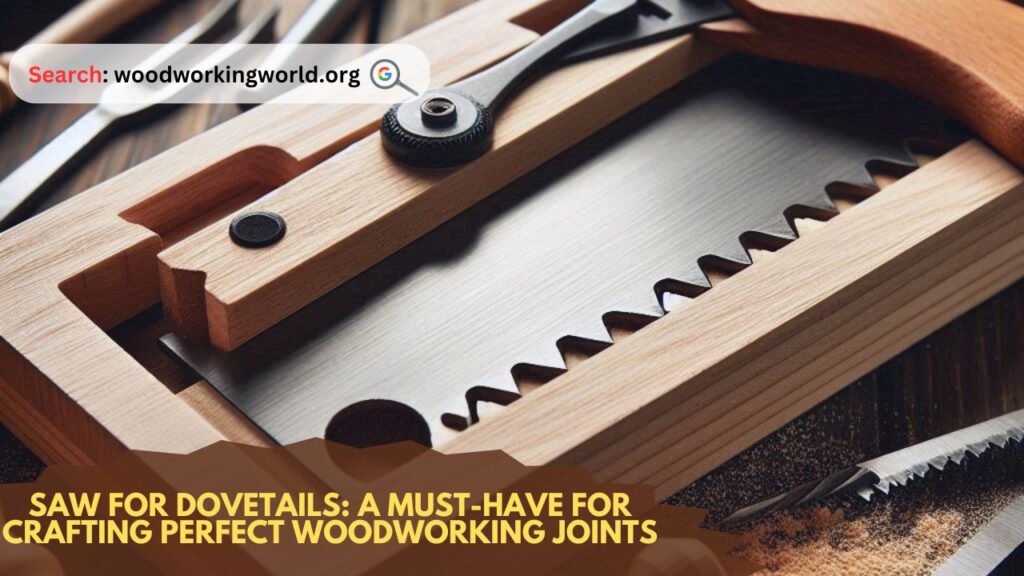Saw for Dovetails: A Must-Have for Crafting Perfect Woodworking Joints
Dovetail joints are one of the most beautiful and durable woodworking techniques. They not only add strength to your projects but also showcase the skill and craftsmanship of the woodworker. To achieve perfect dovetail joints, having the right tools is essential, and the dovetail saw stands as the most critical one.
This guide will explore why the dovetail saw is a must-have tool, how to choose the best one, and step-by-step instructions for crafting flawless dovetail joints.

What is a Dovetail Saw?
A dovetail saw is a small backsaw designed for precision cuts in woodworking. It features a reinforced spine that provides stability and keeps the blade straight during cuts. The teeth are finely spaced and often filed for rip cutting, making it ideal for cutting along the grain.
Key Features:
- Reinforced Spine: Provides rigidity and control.
- Fine Teeth: Typically between 14 to 20 teeth per inch (TPI).
- Narrow Blade: Allows for intricate and precise cuts.
- Comfortable Handle: Ensures a firm grip during detailed work.
Quote: “A dovetail saw is to a woodworker what a scalpel is to a surgeon — precision is everything.”
Why You Need a Dovetail Saw
1. Precision Cutting
The fine teeth and narrow blade of a dovetail saw allow for accurate cuts essential for dovetail joints.
2. Clean, Smooth Cuts
The saw’s sharp teeth reduce tear-out and produce clean cuts, minimizing the need for extensive sanding.
3. Versatility
While primarily designed for dovetails, this saw is also excellent for other joinery tasks requiring precise cuts.
4. Enhanced Craftsmanship
Using a dovetail saw improves the overall quality and appearance of your woodworking projects.
Tip: Practice on scrap wood before tackling your final project to master the sawing technique.
Start Your Next Project With Teds’ Archive Of 16,000 Plans!
Instant access to all 16,000 woodworking plans with step-by-step details, photos, materials lists and more
Monthly free plans with lifetime membership access – No renewals, recurring fees or other charges


Choosing the Right Dovetail Saw
When selecting a dovetail saw, consider the following factors:
1. Tooth Configuration (TPI)
- 14-16 TPI: Ideal for softer woods.
- 17-20 TPI: Best for hardwoods and fine details.
2. Blade Length
- A shorter blade (6-8 inches) offers better control for detailed work.
3. Handle Comfort
- Choose a saw with an ergonomic handle that fits comfortably in your hand.
4. Saw Quality and Brand
- Look for reputable brands such as Lie-Nielsen, Veritas, and Pax.
Tip: A high-quality dovetail saw may have a higher upfront cost but will deliver superior results and last for years.
Step-by-Step Guide to Crafting Perfect Dovetail Joints
Step 1: Prepare Your Wood
- Select two pieces of wood for the joint.
- Ensure both pieces are square and of equal thickness.
- Mark the desired length and width for the dovetail joint.
Tip: Use hardwood for stronger and more durable joints.
Step 2: Mark the Dovetail Layout
- Use a marking gauge to define the depth of the tails and pins.
- Draw the layout using a dovetail template and pencil.
- Ensure the angles are consistent for a professional appearance.
Step 3: Saw the Tails
- Clamp the wood securely in a vise.
- Position the dovetail saw on the waste side of the layout line.
- Start sawing with a light forward stroke to establish the cut.
- Maintain a steady angle and saw down to the marked depth.
Tip: Keep your wrist and forearm aligned to ensure straight cuts.
Step 4: Remove Waste Material
- Use a coping saw or chisel to remove the waste between the tails.
- Clean up the edges with a sharp chisel for crisp lines.
Step 5: Mark and Saw the Pins
- Place the tail piece over the pin board and mark the pin locations.
- Saw along the waste side of the marked lines.
Tip: Take your time to ensure accurate cuts.
Step 6: Test Fit the Joint
- Assemble the joint without glue to check the fit.
- Make minor adjustments with a chisel if needed.
Step 7: Glue and Clamp
- Apply wood glue to the mating surfaces.
- Assemble the joint and clamp it securely.
- Wipe off any excess glue with a damp cloth.
Tip: Allow the glue to cure for at least 24 hours for maximum strength.
Tips for Success
- Practice Makes Perfect: Start with practice joints to hone your skills.
- Maintain Sharp Tools: Keep your dovetail saw and chisels sharp for clean cuts.
- Use a Guide Block: Clamp a guide block to help maintain consistent angles.
- Check Alignment: Ensure your cuts are square and accurate.
Quote: “The secret to perfect dovetails lies in precision, patience, and the right tools.”
Common Mistakes to Avoid
1. Sawing on the Wrong Side of the Line
- Always cut on the waste side to maintain the correct dimensions.
2. Inconsistent Angles
- Use a dovetail template or guide for consistent results.
3. Forcing the Fit
- If the joint doesn’t fit, make small adjustments rather than forcing it.
4. Skipping the Test Fit
- Always test fit the joint before gluing to avoid errors.
FAQs
1. Can I use a dovetail saw for other woodworking tasks?
Yes, dovetail saws are versatile and can be used for other precise cuts, such as tenons and miters.
2. How do I maintain my dovetail saw?
Keep the teeth sharp, clean the blade after each use, and store it in a dry place.
3. What type of wood is best for dovetail joints?
Hardwoods like maple, oak, and walnut provide strong and durable joints.
4. How long does it take to master dovetail joints?
With regular practice, you can achieve mastery within a few months.
5. What should I do if my cuts are uneven?
Check your technique, ensure the saw is sharp, and use a guide block for assistance.
Conclusion
A dovetail saw is an essential tool for any woodworker aiming to craft perfect joints. By understanding its features, choosing the right model, and mastering the proper techniques, you can elevate your woodworking projects to a professional level. Invest in a quality dovetail saw, practice diligently, and watch your craftsmanship flourish.